November 14th Scots’ Book of Days – 1331 David Bruce 2nd king of Scots crowned at Scone with Johanna, Queen and daughter of Edward 2nd of England.
November 14 – 1331 David Bruce 2nd king of Scots crowned at Scone with Johanna, Queen and daughter of Edward 2nd of England. (decends from Duncan and Malcolm, Kings of Scots) Anderson’s Scots History v.2/p.25-27.
- Brus or Bruce 1050 2Stewart2Kennedy 2Montgomery2Blair 2Cochrane2Miller 2Simmons2Choate zoe ToaG
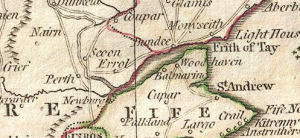 Scone [Scoon] lies in the historical province of Gowrie, north of Perth and Errol (left third of the map, just above the middle). Old Scone was the historic capital of the Kingdom of Alba (Scotland). In the Middle Ages [Scoon] was an important royal centre, used as a royal residence and as the coronation site of the kingdom’s monarchs. Around the royal site grew the town of Perth and the Abbey of Scone. Also in the map is Fife, Flakland, Largo, Crail, St Andrew (on the Coast) Frith of Tay, Wood Haven, Balmarino, Monyseith, Coupar, Dundee, Nairn, Grier. Map section from 1799 Clement Cruttwell Map of Scotland Geographicus. Location for coronation (crowning) of the Kings of Alba, then Scotland, over the Stone of Scone, the traditional rock pillow upon which Jacob slept in the book of Genesis. Edward 1st of England stole the stone and moved it to London for the crowining of English Kings. And so it was, except for Henry 7th who was crowned on the field of Bosworth August 25, 1485.
Scone [Scoon] lies in the historical province of Gowrie, north of Perth and Errol (left third of the map, just above the middle). Old Scone was the historic capital of the Kingdom of Alba (Scotland). In the Middle Ages [Scoon] was an important royal centre, used as a royal residence and as the coronation site of the kingdom’s monarchs. Around the royal site grew the town of Perth and the Abbey of Scone. Also in the map is Fife, Flakland, Largo, Crail, St Andrew (on the Coast) Frith of Tay, Wood Haven, Balmarino, Monyseith, Coupar, Dundee, Nairn, Grier. Map section from 1799 Clement Cruttwell Map of Scotland Geographicus. Location for coronation (crowning) of the Kings of Alba, then Scotland, over the Stone of Scone, the traditional rock pillow upon which Jacob slept in the book of Genesis. Edward 1st of England stole the stone and moved it to London for the crowining of English Kings. And so it was, except for Henry 7th who was crowned on the field of Bosworth August 25, 1485.
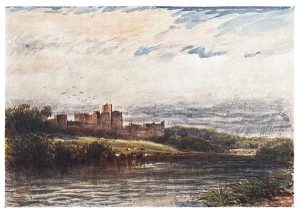 1462 George Douglas,4th Earl of Angus, died. He was warden of the middle marches, since 1449, advanced against EDWARD 4th at ALnwick, in 1462, to relieve French garrison, the auld alliance.
1462 George Douglas,4th Earl of Angus, died. He was warden of the middle marches, since 1449, advanced against EDWARD 4th at ALnwick, in 1462, to relieve French garrison, the auld alliance.
ALNWICK CASTLE FROM A WATER-COLOUR SKETCH PAINTED BY JAMES ORROCK, R.I. The Border Country 1906.
1504 Sometime in November. James Hamilton, 1st Earl of Arran granted a divorce from Elizabeth Home, daughter of Alexander Home, 2nd Lord Home.
The marriage was dissolved in 1506, when it was found that her first husband Thomas Hay, a son of John Hay, 1st Lord Hay of Yester, ancestor of the Marquesses of Tweeddale., was still alive at the time of the wedding. Hay had apparently left the country and was thought to be dead when Hamilton married Home in or 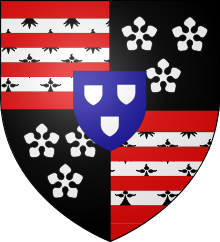 before 1490, but in fact he did not die until 1491 or later. This award of divorce was repeated in 1510, suggesting that Hamilton had continued living with her after 1504, and was held by some to undermine the dissolution of the first marriage as invalid.
before 1490, but in fact he did not die until 1491 or later. This award of divorce was repeated in 1510, suggesting that Hamilton had continued living with her after 1504, and was held by some to undermine the dissolution of the first marriage as invalid.
Arms of the Lord Hay of Yester
Hay Crest: Issuing out of a crest coronet a falcon volant Proper, armed, jessed and belted Or. Motto: SERVA JUGUM. [“Keep the yoke”]. Badge: mistletoe
 Chief: Merlin Sereld Victor Gilbert Moncreiffe, 24th Earl of Erroll. Moncreiffe Crest: Issuing from a crest coronet Or, a demi-lion rampant Gules, armed and langued Azure. Motto: SUR ESPERANCE.
[“Upon hope”].
Badge: oak Chief: Peregrine Moncreiffe of that Ilk. Oak-leaves appear on a stone carving of the 12th laird’s heraldic mantling of 1634.
Chief: Merlin Sereld Victor Gilbert Moncreiffe, 24th Earl of Erroll. Moncreiffe Crest: Issuing from a crest coronet Or, a demi-lion rampant Gules, armed and langued Azure. Motto: SUR ESPERANCE.
[“Upon hope”].
Badge: oak Chief: Peregrine Moncreiffe of that Ilk. Oak-leaves appear on a stone carving of the 12th laird’s heraldic mantling of 1634.
1574 count of Session suspended due to pest with in Edinburgh and Leith, and towns north of Fife. November 14. A History of Epidemics in Britain from A.D. 664 to the Extinction of Plague Charles Creighton, M.A. M.D. Demonstrator of Anatomy University of Cambridge. 1891
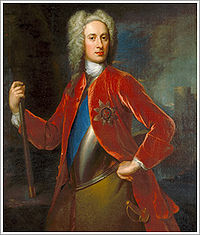 1715 field of battle on Monday, at break of day, the Duke of Argyle found it abandoned by the enemy, [TG71-367]. John Campbell, 2nd Duke of Argyll, 1st Duke of Greenwich (1680–1743) (elder son of the 1st Duke, died without male issue)
1715 field of battle on Monday, at break of day, the Duke of Argyle found it abandoned by the enemy, [TG71-367]. John Campbell, 2nd Duke of Argyll, 1st Duke of Greenwich (1680–1743) (elder son of the 1st Duke, died without male issue)
Campbell Earl of Argyll 1010 2Montgomery2Blair 2Cochrane2Miller 2Simmons2Choate to zoe TOAG
Field Marshal John Campbell, 2nd Duke of Argyll, 1st Duke of Greenwich KG (10 October 1678 – 4 October 1743), known as Iain Ruaidh nan Cath or Red John of the Battles, was a Scottish soldier and nobleman. In the 1715 Jacobite Rebellion, Argyll led the government army at the Battle of Sheriffmuir and defeated the Jacobites led by the Earl of Mar. In 1719 he was rewarded by being created Duke of Greenwich. He was Master General of the Ordnance from 1725 to 1740 and was promoted to Field Marshal in 1736. He is listed as a founding Governor of the Foundling Hospital on that charity’s Royal Charter, granted by the George II in 1739. In 1742, a year before his death, he was given the position of Commander in Chief of the British Army.
1715 – Preston, Lancashire, England. 1,468 Jacobites surrender and are taken prisoner, 463 of them English. George Seton, 5t h Earl of Winton, William Gordon, 6th Viscount of Kenmure, William Maxwell, 5th Earl of Nithsdale and James Radclyffe, 3rd Earl of Derwentwater were among those captured.
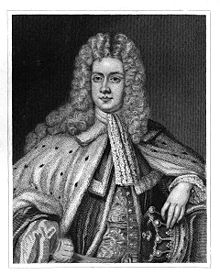 James Radclyffe, 3rd Earl of Derwentwater was the son of Edward Radclyffe, 2nd Earl of Derwentwater and Lady Mary Tudor, the natural daughter of Charles II by Moll Davis. He was brought up at the exile court of St Germain as a companion to the young prince, James Francis Edward Stuart (the ‘Old Pretender’ after his father James II died), and remained there at the wish of Queen Mary of Modena, until his father’s death in 1705. He succeeded to the family titles and estates in Northumberland on the death of his father in 1705. 637 Scots captured at Preston, Lancashire, on 14 Nov 1715, were transported to the American colonies in 1716. As compiled from ten ship manifests, prisoners were sent as indentured servants for a seven-year period.
James Radclyffe, 3rd Earl of Derwentwater was the son of Edward Radclyffe, 2nd Earl of Derwentwater and Lady Mary Tudor, the natural daughter of Charles II by Moll Davis. He was brought up at the exile court of St Germain as a companion to the young prince, James Francis Edward Stuart (the ‘Old Pretender’ after his father James II died), and remained there at the wish of Queen Mary of Modena, until his father’s death in 1705. He succeeded to the family titles and estates in Northumberland on the death of his father in 1705. 637 Scots captured at Preston, Lancashire, on 14 Nov 1715, were transported to the American colonies in 1716. As compiled from ten ship manifests, prisoners were sent as indentured servants for a seven-year period.
1745 – Edinburgh. The Lord Justice Clerk, the Lords of Session, the Sheriffs of the three counties of Lothian, with many other Whig gentlemen who had left the town on the approach of the rebels, had re-entered. Murray conducted the Siege of Carlisle but when the town was surrendered on the 14th November, he resigned his command on the grounds that his authority had been undermined by the Prince, and obtained permission to serve as a volunteer in the Atholl levies.
[TG79-214] Edinburgh in a kind of solemn procession,
1769 earthquake. Inverness. Several fatalities. Mormon 8:30 And there shall also be earthquakes in divers places. ‘Repent, repent ye, Hear the words of that God who made you, by the voice of earthquakes.’ Jesus Christ in Doctrine and Covenants section 43.
1831 Bristol Riots of 1831 On November 14, 1831, Sir Walter Scott is traveling to historic sites, and hoping to improve his health. As recorded in his journal, the party on board hears disturbing news on happenings back home…
‘…We stood into the Bay of Gibraltar and approached the harbour firing a gun and hoisting a signal for a boat: one accordingly came off—a man-of-war’s boat—but refused to have any communication with us on account of the quarantine, so we can send no letters ashore, and after some pourparlers, Mr. L——, instead of joining his regiment, must remain on board. We learned an unpleasant piece of news. There has been a tumult at Bristol and some rioters shot, it is said fifty or sixty. I would flatter myself that this is rather good news, since it seems to be no part of a formed insurrection, but an accidental scuffle in which the mob have had the worst, and which, like Tranent, Manchester, and Bonnymoor, have always had the effect of quieting the people and alarming men of property. The Whigs will find it impossible to permit men to be plundered by a few blackguards called by them the people, and education and property probably will recover an ascendency which they have only lost by faintheartedness.’
The spark for the Bristol Riots was rejection by the House of Lords of a reform bill, which would have provided Bristol and other cities with greater representation in the House of Commons. In “History of the Peace…”, Harriet Martineau and Charles Knight depict a situation that was exploited by nefarious intrests based in London. ‘London rogues could have had no such power as in this case if the political and moral state of Bristol had not been bad. Its political state was disgraceful. The venality of its elections was notorious. It had a close corporation, between whom and the citizens there was no community of feeling on municipal subjects. The lower parts of the city were the harbourage of probably a worse seaport populace than any other place in England, while the police was ineffective and demoralised. There was no city in which a greater amount of savagery lay beneath a society proud, exclusive, and mutually repellent, rather than enlightened and accustomed to social co-operatiou. These are circumstances which go far to account for the Bristol riots being so fearfully bad as they were. Of this city, Sir Charles Wotherell— then at the height of his unpopularity as a vigorous opponent of the Reform Bill—was recorder; and there he had to go, in the last days of October, in his judicial capacity. Strenuous efforts had been made to exhibit before the eyes of the Bristol people the difference between the political and judicial functions of their recorder, and to shew them that to receive the judge with respect was not to countenance his political course; yet the symptoms of discontent were such as to induce the mayor, Mr l’inney, to apply to the home-office for military aid. Lord Melbourne sent down some troops of horse, which were quartered within reach, in the neighbourhood of the city. It was an unfortunate circumstance that, owing to the want of a common interest between the citizens and the corporation, scarcely any gentlemen offered their services as special constables but such as were accustomed to consider the lower classes with contempt as a troublesome rabble, and rather relished an occasion for defying and humbling them.
1871 Day after Robert Louis Stevenson’s 21st birthday. Already a prolific story teller.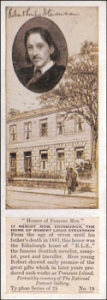
| 17 HERIOT ROW, EDINBURGH, THE HOME OF ROBERT LOUIS STEVENSON. From the age of seven until is father’s death in 1887, this house was the Edinburgh home of “R.L.S.,” the famous Scottish novelist, essayist, poet and traveler. Here young Robert showed early promise of the great gifts which in later years produced such works as Treasure Island. Portrait by The National Portrait Gallery. www.englishteastore.com/typhoo-history-cards-set-8.html |
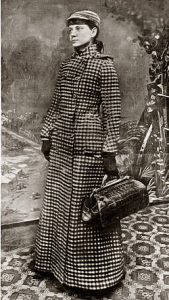 1889 Nellie Bly, born Elizabeth Jane Cochran. (clan Cochrane) She left by steam ship for a trip around the world to beat Phileas Fogg, the fictional hero of Jules Verne’s “Around the World in Eighty Days.” She went by England to France, met Jules Verne, thru the Suez Canal, to Ceylon, Singapore, Hong Kong, and Japan. Stories were sent by submarine cable and telegraph. Traveling by ship, train and burro, she returned back to New York in 72 days, 6 hours and 11 minutes as a celebrity.
1889 Nellie Bly, born Elizabeth Jane Cochran. (clan Cochrane) She left by steam ship for a trip around the world to beat Phileas Fogg, the fictional hero of Jules Verne’s “Around the World in Eighty Days.” She went by England to France, met Jules Verne, thru the Suez Canal, to Ceylon, Singapore, Hong Kong, and Japan. Stories were sent by submarine cable and telegraph. Traveling by ship, train and burro, she returned back to New York in 72 days, 6 hours and 11 minutes as a celebrity.
A publicity photo taken by the New York World newspaper to promote Bly’s around-the-world voyage. She made a Broadway musical for February 4, 1946, by Van Heusen.
1907 November 14 Howard W. Hunter, born, (1907-1995) becomes 14th President of the Church of Jesus Christ of Latter Day Saints. The Hunters are from Paisley Renfrewshire Scotland. President Howard W. Hunter: The Lord’s “Good and Faithful Servant” Ensign Apr 1995. ( clan Hunter)
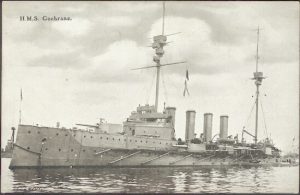 1918 HMS Cochrane (Lead Ship) “Warrior” Class Armoured Cruiser. Built by Fairfield Shipbuilding & Engineering Co., Govan, Glasgow February 1907. Served most of the Great War with the Grand Fleet and took part in the Battle of Jutland in 1916. Wrecked in the Mersey Estuary (River Mersey near Liverpool) November 14th 1918.
1918 HMS Cochrane (Lead Ship) “Warrior” Class Armoured Cruiser. Built by Fairfield Shipbuilding & Engineering Co., Govan, Glasgow February 1907. Served most of the Great War with the Grand Fleet and took part in the Battle of Jutland in 1916. Wrecked in the Mersey Estuary (River Mersey near Liverpool) November 14th 1918.
Main guns 6, Secondary gus 4, Torpedo tubes and other weapons.
1940 Blitz bombs Coventry. Night-time attacks on London and other ports and cities carried on through to May 1941. German cities also were targets for the RAF.
 1966 Gemini 12 (officially Gemini XII) Buzz Aldrin’s 3rd space walk swim,
1966 Gemini 12 (officially Gemini XII) Buzz Aldrin’s 3rd space walk swim,
![]() Aldrin with Earth in his visor’s reflection. [Clan Munro]
Aldrin with Earth in his visor’s reflection. [Clan Munro]
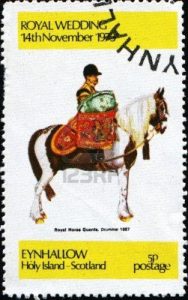 1979 www.123rf.com – Royal Wedding 14th November 1979.
1979 www.123rf.com – Royal Wedding 14th November 1979.
Eynhallow, Holy Island Scotland Royal Horse Guards Drummer 1887
2003 Master and Commander: The Far Side of the World, movie released. The film’s plot and characters are adapted from three novels in author Patrick O’Brian’s Aubrey–Maturin series which has a total of 20 novels of fictional Jack Aubrey’s naval career. 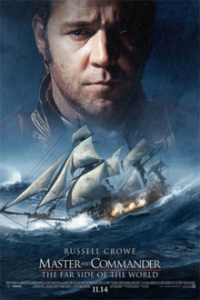 Aubrey, in turn, exploits and reverses are directly based on the career of Thomas Cochrane (historical Naval commander, clan Cochrane), most importantly the plots of Master and Commander, The Reverse of the Medal and Blue at the Mizzen. In Master and Commander, fictional Aubrey attributes his education to “Queeny,” the wife to Lord Keith, (clan Keith) the historical Hester Thrale. Her family had occupied Damplow, a house near fictional General Aubrey’s estate and Jack learned mathematics and Latin from her.
Aubrey, in turn, exploits and reverses are directly based on the career of Thomas Cochrane (historical Naval commander, clan Cochrane), most importantly the plots of Master and Commander, The Reverse of the Medal and Blue at the Mizzen. In Master and Commander, fictional Aubrey attributes his education to “Queeny,” the wife to Lord Keith, (clan Keith) the historical Hester Thrale. Her family had occupied Damplow, a house near fictional General Aubrey’s estate and Jack learned mathematics and Latin from her.
Theatrical release poster. Russel Crowe.
Disclaimer: The author of each article published on this web site owns his or her own words. The opinions, beliefs and viewpoints expressed by the various authors and forum participants on this site do not necessarily reflect the opinions, beliefs and viewpoints of Utah Standard News or official policies of the USN and may actually reflect positions that USN actively opposes. No claim in public domain or fair use. © John Choate
Utah Standard News depends on the support of readers like you.
Good Journalism requires time, expertise, passion and money. We know you appreciate the coverage here. Please help us to continue as an alternative news website by becoming a subscriber or making a donation. To learn more about our subscription options or make a donation, click here.
To Advertise on UtahStandardNews.com, please contact us at: ed@utahstandardnews.com.


Comments - No Responses to “November 14th Scots’ Book of Days – 1331 David Bruce 2nd king of Scots crowned at Scone with Johanna, Queen and daughter of Edward 2nd of England.”
Sure is empty down here...